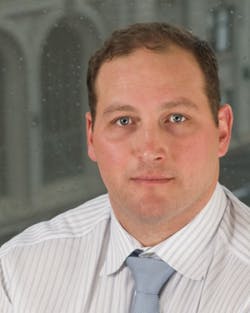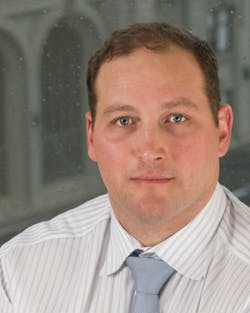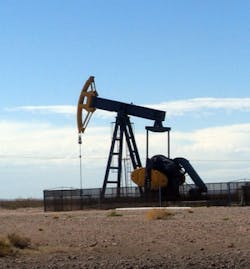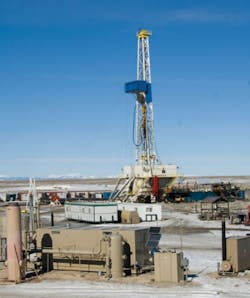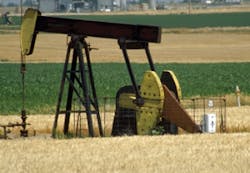Triangle Petroleum building its position in the Bakken
Poised for growth in the Williston Basin, one of North America's largest oil producing regions.
All photos courtesy of Triangle Petroleum.
OIL & GAS FINANCIAL JOURNAL: The Williston Basin is one of the most prolific oil basins in North America. Competition for land and services is fierce. How did Triangle Petroleum enter the play and what is your overall growth strategy?
JONATHAN SAMUELS: Triangle first entered the play in the beginning of 2009 through a partnership with Slawson Exploration. Triangle had recently restructured and one of our strategic growth goals was to find a way into the Bakken [shale play]. Although privately held, Slawson is one of the largest operators in the Williston Basin and a solid fit with our organization. In terms of overall growth, we are looking to build a portfolio of both non-operated and operated positions throughout the basin. This basin measures in at 12,500 square miles and has more than 250 billion barrels of oil in place. Using even conservative estimates for recovery factors, it's easily the largest in North America and is truly an asset with global strategic significance to the nation.
OGFJ: You have both an operated and a non-operated position in the basin. How does your non-operated position work to your advantage?
SAMUELS: Great question. The non-operated and operated businesses feed off each other. Non-operated positions trade at a meaningful discount to operated positions, but it doesn't change the amount of oil there. We see a lot of packages with operated and non-operated positions, and in those situations we may be the only bidder. The non-operated model also allows us to build our production and reserve base as we simultaneously build our company. We believe we're building shareholder value through our growth, cash flow, and other near-term catalysts associated with our non-operated position, while at the same time we believe we have the significant upside potential of a large operated position, which typically sells for a much larger premium. As we see it, there is great opportunity to convert non-operated acreage purchased at a discount into operated acreage valued at a premium as other operators look to core up their positions.
OGFJ: Which companies are Triangle's key operating partners, and why have you chosen to explore the Williston Basin with them?
SAMUELS: We have taken deliberate steps to partner with the best operators in the Bakken. Our company partners with 15 operators on our 23,000 net non-operated acres located primarily in McKenzie County. We work most often with Slawson Exploration and Kodiak Oil and Gas. We first entered into our partnership with Slawson because of the respect we have for them as operators as well as their business sense. Kodiak is a company we have known for a long-time in various capacities as industry-leaders. Within Triangle, we first worked with them in our McKenzie County project. Choosing the right operating partners is critical, and we examine each company's objectives and goals to make sure they are aligned with ours.
OGFJ: Triangle operates 7,000 net acres of its 30,000 net acre position. What are your development plans for the operated acreage both near-term and long-term?
SAMUELS: Over the near term, we are focused on building our team as we prepare to drill our first operated well towards the end of this year. We have recruited top talent with experience in the Williston Basin, and we have aligned our operations and business interests. Over the long-term, we want to be as efficient as possible and drill up our operated position as quickly as possible. Acreage value is nice, but the true measure of value is what shareholders own in terms of reserves, production, and cash flow, measured on a per-share basis. The industry has yet to begin downspacing outside the original Parshall and Sanish areas, and that is ultimately where the play is headed. We want to play a role in the development.
OGFJ: Competition for services is running high and the cost for crews continues to increase in the Williston Basin. What steps are you taking to control and manage these costs?
SAMUELS: Costs are high. However, it's important to distinguish between true inflation and increasing completion intensity. This is more expensive but should yield more in terms of EUR [estimated ultimate recovery] and first-year production, if it was a wise economic decision. Our view on costs is that you have to earn a good return on capital on well one, full stop. But we are also of the opinion that the real value here is in the four to seven additional drilling locations per unit when you think about downspacing. Currently, infrastructure and services in the Williston Basin are about as strained as they can be. So if we're paying a 10% premium on an $8 million well, you have to ask yourself if you are willing to pay an $800,000 premium to secure 1.5 to 3.5 million additional barrels of recoverable reserves. We are. As time passes and the service industry catches up, it will get better. And there will be pullbacks in the macro-level economy that will allow industry to catch its breath.
Triangle aims to drill its first operated well in the Bakken by year-end 2011.
OGFJ: What are the economics on your wells?
SAMUELS: We model $8.0 million per well, some more and some less, depending on the area and the operator. In general, we model in an average of 450,000 barrels of recoverable oil per well, but a lot of our peers would say we're low. Even using our more conservative numbers, it results in finding and development costs below $20 per barrel, which is fantastic in a play as statistical as the Bakken. But the real key for us is the payback period, which for the majority of wells occurs within the first two years of its life assuming $80 per barrel oil. As a smaller operator, our economics are further improved by our low-cost entry into the play. We have been fortunate to be able to accumulate our position of 30,000 net acres in the core Williston Basin at an average price of $2,600 per acre.
The management team at Triangle is actively allocating capital toward accumulating 100,000 acres in the Bakken.
OGFJ: Can you tell us about Triangle's capital budget for 2011 in terms of allocation, priorities and the expected results?
SAMUELS: We have a 2011 capital budget of approximately $150 million. The bulk of that spending is going to drilling, and we plan to spud nine net non-operated wells and 1.6 net operated wells. Our priorities right now are to increase cash flow and reserves, and continue to build our operated acreage position. Our expectations are that we exit the year with significant growth in our reserve base, although admittedly we are starting from a low base. However, we feel that our growth should be astounding. In the past, we have been upfront with our goal of accumulating more than over 100,000 net acres in the Williston Basin. For us, we are going to continue exploring acreage opportunities in what we consider the core or fairway of the Bakken. We have allocated approximately $50 million for these potential acquisitions during 2011. The remainder of our budget will be used to fund infrastructure projects as well as general working capital.
OGFJ: You also have a large land position in Nova Scotia, in eastern Canada. What are your growth plans for this portfolio?
SAMUELS: Our land position in Nova Scotia is a legacy asset. Early drilling results were unsuccessful and the primary issue is current gas prices, which are too low to justify exploratory drilling. We know there is a lot of gas in place, but getting it out involves a lot of technical risk. I personally think Nova Scotia has the ability to become a material gas producer over the long-run and is ideally situated for LNG export. However, a lot of capital has to be spent to get there and not all of it will earn a profit. We are patient and will keep a close eye on the work being done by the large independents next to us in New Brunswick, which is analog to our position. I do want to mention that we consider ourselves Bakken players, and that is where the overwhelming majority of our time and money is being concentrated.
Leveraging its experience as a non-operator to some of the top companies in the Bakken, Triangle has tangible, near-term growth potential.
Dr. Peter Hill – CEO.
OGFJ: Can you tell us about your hedging strategy? What percentage of your production is currently hedged and at what prices?
SAMUELS: We currently have no hedges in place for 2011. We are still in our growth phase and our net production is approximately 115 BOPD. However, with increased production and reserves coming from the 10.6 net wells we expect to drill and complete in 2011, we are headed in that direction. We like to consider ourselves conservative when thinking about our hedges. We want to monetize what is in the ground in order to take care of our near-term financial obligations. We are currently in the process of putting together a reserve-based lending facility, and our hedge program will be largely centered around those financial obligations. We are one of the lucky, smaller operators that is fortunate to have zero debt on our balance sheet. I am a firm believer in asset and liability matching and we hope to lock in some of the economics and cash flow that can be used to meet our committed capital.
OGFJ: Will you operate within cash-flow in 2011?
SAMUELS: We will operate within cash-flow and cash in the bank. We are fully funded for our 2011 program and have no debt. Our strong financial position and balance sheet is vital to our future growth, development, and expansion in the Williston Basin.
OGFJ: Is there anything we haven't covered that you would like to add?
SAMUELS: The main thing I would stress is that 25 billion recoverable barrels is a very big number, so we're only in the first or second inning of the game. And every operator has a huge call option on ultimate downspacing and technology improvement, which is currently on a Moore's Law type curve. We think the value of politically-secure, domestically-produced oil will only increase over time. And industry has a great partner in the states of North Dakota and Montana. We think this only gets better from here.We at Triangle also believe we have a role to play in how these tremendous reserves are developed to the benefit of all stakeholders. We have come a long way since we entered the basin in early 2010 with a market cap of $5million. Today with 30,000 net acres, $120million in cash, a market cap of $300milion, and an AMEX listing, we have developed a momentum to continue that growth. We think this only gets better from here.
More Oil & Gas Financial Journal Current Issue Articles
More Oil & Gas Financial Journal Archives Issue Articles
View Oil and Gas Articles on PennEnergy.com
